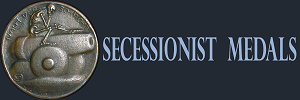Artur Immanuel Löwental (Loewental). 1914.
GENERALOBERST ——— VON・HINDENBURG (Colonel General von Hindenburg). Cast yellow bronze, light-brown patina with field outside of image burnished, 104.1 mm, 372.18 g. Edge-punch 2 0 0 (example number of an unnumbered edition at 2 o'clock). Vorzüglich (extremely fine).
Obverse: Three-quarters head-and-shoulders portrait bust to left in full military uniform, epaulettes, be-medaled, Order of the Black Eagle at collar; title legend on hammered band encircling upper edge divided by image.
Reverse: Armored medieval knight striding to right, un-helmeted head turned to left, both hands wielding broadsword over left shoulder, poised to strike; background marsh grasses at left, burning village at right; legend DER・RUSSEN・BEZWINGER ——— OSTPREUSSENS・BEFREIER (conqueror of the Russians; East Prussia's liberator) on hammered band encircling edge, divided by image; two-line inscription TANNEN / BERG center left; two-line inscription ORTELS / BURG center right; year date 1914 lower center; artist's signature ALÖWENTAL lower right inside border band; maker's signature GRÜNTHALS lower left on border band.
Cf: Schulman. 1916. La Guerre Européenne, Catalogue LXV, p. 65: no. 668. Bronze and iron examples.
Cf: Frankenhuis, M. 1919(?). Catalogue of Medals - Medalets and Plaques Relative to the World War 1914 - 1919, p. 78: no 578.
Cf: Turner, John T. 2014. Artur Immanuel Loewental 1879 - 1964: a brief introduction to his life and work, together with a selected list of his sculpted works, p. 60: LOE46 (also listing some other variants).
Cf: Klose, Dietrich O. A. 2016. Europas Verderben 1914 1918: Deutsche und österreichische Medaillen auf den Ersten Weltkrieg, p. 128: 10.3 (iron example).
Cf: Phagan, P., and P. van Alfen. 2017. The Art of Devastation: Medals and Posters of the Great War, p. 198: cat. no. 5 (bronze example w/o signature or foundry stamp, hammered band). Online reference and images: http://numismatics.org/collection/1984.92.1.This is the first of two medals by Löwental commemorating General Paul von Hindenburg's smashing of the Russian invasion of East Prussia in August 1914 at the Battle(s) of Tannenberg (of which an early engagement was at the village of Ortelsburg). On the present medal, his rank is recorded as
Generaloberst, as it was at the time of the battle, but the second medal, produced the following year, commemorates Hindenburg's subsequent promotion to
Generalfeldmarschall, and the reverse depicts "How the Hero Siegfried bound the [Russian] Bear." See my previous post.
Both were very popular medals: small-format copies were struck in silver and bronze, and the large versions cast in iron and bronze. Of large bronze examples of the 1914 medal, there appear to be at least three minor variants. Images on obverse and reverse are the same, but there are minor differences in the artist's incised signature and maker's marks, and there are two finishes (smooth and hammered) on the legend bands encircling the edges.
Several diameters are recorded, which may indicate differences in edge finishing or approximate measuring. Published measurements of 110 mm, 114 mm, and 115 mm (Turner, p. 60; ANS collection - online listing above) indicate unusually large examples, but without such examples in hand, it is impossible to confirm larger image sizes as well. The single surviving plaster cast model has a diameter of 104 mm (Turner, p. 60: LOE047).
The manufacturer (maker) of this medal was Robert Ball Nachfolger Münzhandlung (Robert Ball Successors Coin Dealers), Berlin. Hugo Grünthal (1869 - 1943), proprietor of the firm, commissioned the medal from Löwental (Turner, p. 60). The medals are thus marked with either Balls Nachfolger or Grünthal as well as various spellings of the artist's name.
The list below is summarized from examination of images and descriptions in auction house archives, online collection records, and a few reference books. Only the medal described in detail above has actually been handled, so the list and descriptions should not be taken as definitive. Variants 1, 2 , and 4 (iron) likely are the earlier productions, as the chasing of finished casts is more detailed (e.g. hammered legend bands), the medals bear the sponsor's name (Grünthal) rather than that of the company, and the bronze examples are individually numbered.
Bronze variant 1: cast, 103 mm; 105 mm. Obverse: unsigned, unmarked. Reverse: ALÖWENTAL (A and L ligatured) / GRÜNTHAL. Hammered (pebbled) legend bands. Edge-punch: example number (edition limit unknown).
Bronze variant 2: cast, 104 mm; 115 mm. Obverse: unsigned, unmarked. Reverse: unsigned, unmarked. Hammered legend bands. Edge-punch: A.LOEWENTHAL — GRÜNTHAL — example number (edition limit unknown).
Edge-punch also listed as: A. LÖWENTHAL — GRÜNTHAL.
Bronze variant 3: cast or struck(?), 103 mm; 105 mm. Obverse: unsigned, unmarked. Reverse: BALLS NACHFOLGER / ALÖWENTAL (A and L ligatured) or ALŒWENTAL (A and L, O and E ligatured). Smooth legend bands. This variant has been described as struck (ANS collection
http://numismatics.org/collection/2000.1.484).
Iron issue: cast, 103 mm; 105 mm; 115 mm. Obverse: ALÖWENTAL (A and L ligatured). Reverse: GRÜNTHAL. Smooth legend bands (or with faint traces of pebbling from the mold).

 Recent Posts
Recent Posts